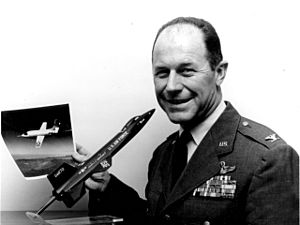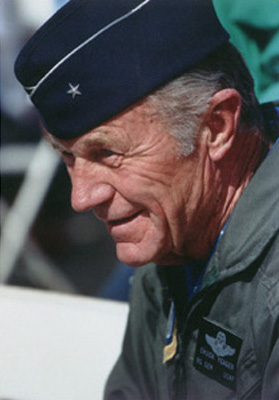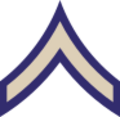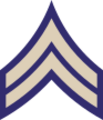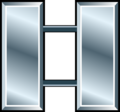Chuck Yeager facts for kids
Quick facts for kids
Chuck Yeager
|
|
|---|---|

Brigadier General Chuck Yeager
|
|
| Birth name | Charles Elwood Yeager |
| Born | February 13, 1923 Myra, West Virginia |
| Died | December 7, 2020 (aged 97) Los Angeles, California |
| Allegiance | United States |
| Service/ |
United States Army United States Air Force |
| Years of service | 1941–1947 (Army) 1947–1975 (Air Force) |
| Rank | Brigadier General |
| Battles/wars | |
| Awards |
|
| Spouse(s) |
|
| Children | 4 |
| Relations | Steve Yeager (cousin) |
| Other work | Flight instructor and test pilot |
| Signature | |
Charles Elwood Yeager (pronounced YAY-gər), born on February 13, 1923, and passing away on December 7, 2020, was a famous American Air Force officer. He was a flying ace and a record-setting test pilot. In 1947, he made history by becoming the first person confirmed to fly faster than the speed of sound in level flight.
Yeager's journey began in World War II. He joined the United States Army in 1941. He started as an aircraft mechanic. In 1942, he began pilot training. He became a flight officer and flew P-51 Mustang fighter planes. He was very successful, shooting down 11.5 enemy aircraft. On October 12, 1944, he became an "ace in a day" by shooting down five enemy planes in one mission.
After the war, Yeager became a test pilot. He flew many different kinds of planes. This included experimental rocket-powered aircraft. These were for the National Advisory Committee for Aeronautics. He officially broke the sound barrier on October 14, 1947. He flew the Bell X-1 at Mach 1 (the speed of sound). This happened at an altitude of 13,700 meters (45,000 feet). For this amazing feat, he won the Collier Trophy and Mackay Trophy in 1948. He continued to break many other speed and altitude records.
Later in his career, Yeager led fighter squadrons and wings. He served in Germany and Southeast Asia during the Vietnam War. Because his units performed so well, he was promoted to brigadier general in 1969. He retired on March 1, 1975. Yeager's flying career lasted over 30 years. He flew in three major wars and visited many parts of the world. This included the Korean War and the Soviet Union during the Cold War. Throughout his life, he flew more than 360 different types of aircraft.
Contents
Early Life and Education
Chuck Yeager was born on February 13, 1923. His parents, Susie Mae and Albert Hal Yeager, were farmers. They lived in Myra, West Virginia. When he was five, his family moved to Hamlin, West Virginia. He had two brothers and two sisters.
He went to Hamlin High School. There, he played basketball and football. He was best at geometry and typing. He finished high school in June 1941. Before joining the military, he attended a training camp. This was at Fort Benjamin Harrison in Indiana. He went during the summers of 1939 and 1940. On February 26, 1945, Yeager married Glennis Dickhouse. They had four children together. Glennis passed away in 1990.
Yeager was also a cousin of former baseball player Steve Yeager.
Amazing Flying Career
Joining the Army Air Forces
Yeager joined the U.S. Army Air Forces (USAAF) on September 12, 1941. He started as an aircraft mechanic in California. At first, he was too young for flight training. He also didn't have enough education. But when the U.S. entered World War II, the rules changed. Yeager had incredibly sharp eyesight, which helped him greatly.
He was accepted for flight training. He earned his pilot wings and became a flight officer. This happened on March 10, 1943, in Arizona. He then trained as a fighter pilot. He flew Bell P-39 Airacobras. He was sent overseas with his group in November 1943.
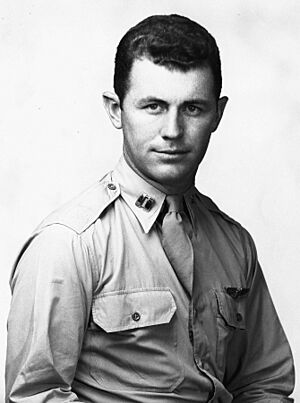
Yeager was stationed in the United Kingdom. He flew P-51 Mustangs in combat. He was part of the 363d Fighter Squadron. He named his plane Glamorous Glen. This was after his girlfriend, Glennis Faye Dickhouse. She later became his wife. Yeager got one victory before his plane was shot down. This happened over France on March 5, 1944. It was only his eighth mission. He managed to escape to Spain. The French Resistance, called the Maquis, helped him. He returned to England in May 1944. While with the Maquis, he helped them build bombs. He learned this skill from his father. He received the Bronze Star Medal for helping another airman escape.
Pilots who had escaped from enemy territory were usually not allowed to fly combat missions again. This rule was to protect resistance groups. But Yeager and another pilot, Fred Glover, spoke directly to General Dwight D. Eisenhower. On June 12, 1944, Eisenhower allowed them to return to combat. Yeager explained that the French Resistance members were no longer in hiding. After this, Yeager shot down his second enemy plane. It was a German Junkers Ju 88 bomber.
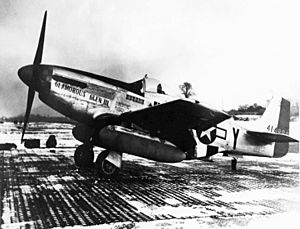
Yeager showed amazing flying skills. On October 12, 1944, he became the first pilot in his group to become an "ace in a day". He shot down five enemy planes in one mission. Two of these were without firing a shot. A German Messerschmitt Bf 109 pilot panicked and crashed into his own wingman. Yeager finished the war with 11.5 official victories. This included one of the first air-to-air victories over a jet fighter. He shot down a German Messerschmitt Me 262 as it was landing.
Yeager became a second lieutenant and then a captain. He flew his last mission on January 15, 1945. He returned to the United States in February. Because he had escaped from enemy territory, he could choose his next assignment. He chose Wilbur Wright Field to be close to his home. His many flight hours and experience made him a test pilot for repaired aircraft. He worked under Colonel Albert Boyd.
Breaking the Sound Barrier
Yeager stayed in the Air Force after the war. He became a test pilot at Muroc Army Air Field. This is now Edwards Air Force Base. A civilian test pilot asked for a lot of money to break the sound barrier. So, the USAAF chose Yeager to fly the rocket-powered Bell XS-1. This was part of a program to study high-speed flight.
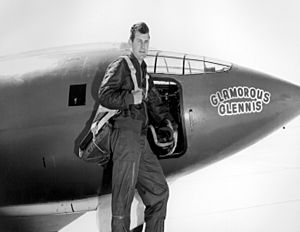
This was a very difficult task. Two nights before the flight, Yeager broke two ribs. He fell from a horse. He was worried this injury would stop him from flying. He only told his friend and fellow pilot Jack Ridley about it. On the day of the flight, Yeager was in too much pain to seal the X-1's hatch by himself. Ridley used a broom handle to help him close it.
Yeager broke the sound barrier on October 14, 1947. He flew the X-1 Glamorous Glennis at Mach 1.05. This was at an altitude of 13,700 meters (45,000 feet). He flew over the Rogers Dry Lake in the Mojave Desert. The public didn't hear about this success until June 1948. Yeager received the Mackay Trophy and the Collier Trophy in 1948. He also got the Harmon International Trophy in 1954. The X-1 plane he flew is now on display at the Smithsonian Institution's National Air and Space Museum.
Yeager continued to break many speed and altitude records. He was one of the first American pilots to fly a MiG-15. This happened after its pilot, No Kum-sok, flew it to South Korea. In 1953, Yeager worked with the USAF team on the X-1A. This plane was designed to fly faster than Mach 2. That year, he flew a chase plane for Jacqueline Cochran. She became the first woman to fly faster than sound.
On November 20, 1953, another team set a new speed record. They reached twice the speed of sound. Yeager and Ridley decided to beat this record. They called their plan "Operation NACA Weep." On December 12, 1953, they set a new record at Mach 2.44. This was just in time to spoil a celebration for the Wright brothers.
The record flight didn't go perfectly. After reaching Mach 2.44, Yeager lost control of the X-1A. This happened at about 24,000 meters (80,000 feet). The plane was rolling, pitching, and yawing out of control. Yeager dropped 15,500 meters (51,000 feet) in less than a minute. He regained control at around 8,800 meters (29,000 feet). He then landed safely. For this, Yeager received the Distinguished Service Medal in 1954.
Military Leadership Roles
Yeager was a fighter pilot first and foremost. He held several leadership positions. From 1954 to 1957, he commanded the 417th Fighter-Bomber Squadron in Germany and France. From 1957 to 1960, he led the 1st Fighter Day Squadron in California and Spain.
In 1962, Yeager became a full colonel. After studying at the Air War College, he became the first leader of the U.S. Air Force Test Pilot School. This school trained astronauts for NASA and the Air Force. Yeager himself had only a high school education. So, he wasn't eligible to become an astronaut. In April 1962, Yeager flew with Neil Armstrong. They were checking a dry lake bed in Nevada. It was for emergency landings for the X-15. Yeager knew the lake bed was too wet. But Armstrong wanted to fly anyway. Their plane got stuck, and they needed rescue.
Between 1963 and 1964, Yeager flew five times in the NASA M2-F1 lifting body. An accident during a test flight in December 1963 ended his record attempts.
In 1966, Yeager took command of the 405th Tactical Fighter Wing in the Philippines. Its squadrons were sent to South Vietnam and other parts of Southeast Asia. He flew 127 missions there. In 1968, Yeager commanded the 4th Tactical Fighter Wing in North Carolina. He led this wing in South Korea during the Pueblo crisis.
Yeager was promoted to brigadier general in July 1969. He became the vice-commander of the Seventeenth Air Force.
From 1971 to 1973, Yeager was sent to Pakistan. He advised the Pakistan Air Force. During the 1971 war between India and Pakistan, his small plane was damaged. This happened during an air raid by the Indian air force. Yeager was very upset about this incident.
After Retirement
On March 1, 1975, Yeager retired from the Air Force. This was after his assignments in Germany and Pakistan.
Yeager appeared briefly in the movie The Right Stuff (1983). He played a bartender named "Fred." This was fitting, as he spent a lot of time at the real "Pancho's Place." Sam Shepard played Yeager's role in the movie.
In the 1980s, Yeager worked with General Motors. He promoted their automotive parts division, AC Delco. He also drove the Chevrolet Corvette pace car for the 1986 Indianapolis 500 race. In 1988, he drove the pace car again. In 1986, President Reagan appointed Yeager to the Rogers Commission. This group investigated the explosion of the Space Shuttle Challenger.
Yeager also advised for three Electronic Arts flight simulator video games. These included Chuck Yeager's Advanced Flight Trainer. The game manuals had quotes and stories from Yeager. Players loved them. The games featured his accomplishments. Players could try to beat his records. Chuck Yeager's Advanced Flight Trainer was Electronic Arts' top-selling game in 1987.
In 2009, Yeager was in a documentary. It was called The Legend of Pancho Barnes and the Happy Bottom Riding Club. This film was about his friend Pancho Barnes. The documentary won an Emmy Award.
On October 14, 1997, Yeager celebrated the 50th anniversary of his historic flight. He flew a new Glamorous Glennis III, an F-15D Eagle, past Mach 1 again. The plane flying alongside him was an F-16 Fighting Falcon. It was piloted by Bob Hoover, a famous test pilot. Hoover had been Yeager's wingman for the first supersonic flight. Yeager said, "All that I am ... I owe to the Air Force." He received the Tony Jannus Award that month.
On October 14, 2012, Yeager broke the sound barrier again. He was 89 years old. He flew as co-pilot in an McDonnell Douglas F-15 Eagle. Captain David Vincent piloted the plane from Nellis Air Force Base.
Awards and Honors
In 1973, Yeager was inducted into the National Aviation Hall of Fame. This is a very high honor in aviation. In 1974, he received the Golden Plate Award. In December 1975, the U.S. Congress gave Yeager a silver medal. It was like a non-combat Medal of Honor. It recognized his contribution to aerospace science. He risked his life flying the X-1 faster than sound. President Gerald Ford presented the medal to Yeager on December 8, 1976.
Many people consider Yeager one of the greatest pilots ever. This is despite him never attending college. He was often modest about his background. Marshall University named its highest academic scholarship, the Society of Yeager Scholars, after him. Yeager also led the Experimental Aircraft Association's Young Eagle Program from 1994 to 2004.
In 1966, Yeager was inducted into the International Air & Space Hall of Fame. He was also inducted into the International Space Hall of Fame in 1981. He was part of the first group inducted into the Aerospace Walk of Honor in 1990.
Yeager Airport in Charleston, West Virginia, is named after him. A bridge over the Kanawha River in Charleston is also named in his honor. On October 19, 2006, West Virginia honored Yeager with a marker. They also renamed part of US Highway 119 the Yeager Highway.
Yeager was an honorary board member of Wings of Hope. This is a humanitarian organization. In 2009, he was inducted into the California Hall of Fame. Flying Magazine ranked Yeager number 5 on its 2013 list of The 51 Heroes of Aviation. For many years, he was the highest-ranked living person on that list.
The Civil Air Patrol awards the Charles E. "Chuck" Yeager Award. This is part of its Aerospace Education program.
Other Achievements
- 1940–1949 – Harmon Trophy: Citation of Honorable Mention
- 1947 – Collier Trophy and Mackay Trophy, for breaking the sound barrier for the first time.
- 1953 – Harmon Trophy
- 1976 – Congressional Silver Medal
Personal Life
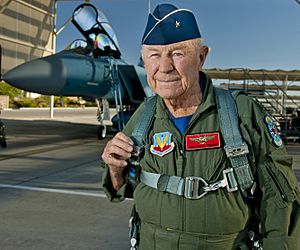
Yeager named his planes after his wife, Glennis. He believed it was a good-luck charm. "You're my good-luck charm, hon. Any airplane I name after you always brings me home," he said. After retiring in 1975, Yeager and Glennis moved to Grass Valley, California. They did well financially from Yeager's best-selling autobiography and speaking events. Glennis Yeager passed away from ovarian cancer in 1990. They had four children: Susan, Don, Mickey, and Sharon. Their son Mickey died in 2011.
Yeager appeared in an advertisement for George H. W. Bush's 1988 presidential campaign.
In 2000, Yeager met actress Victoria Scott D'Angelo. They married in August 2003. Yeager lived in Northern California. He passed away on December 7, 2020, at age 97, in a Los Angeles hospital.
Images for kids
See also
 In Spanish: Chuck Yeager para niños
In Spanish: Chuck Yeager para niños




